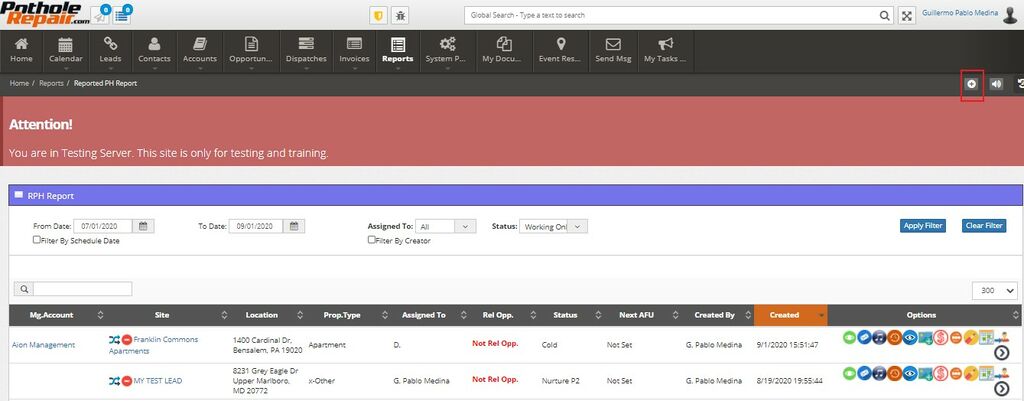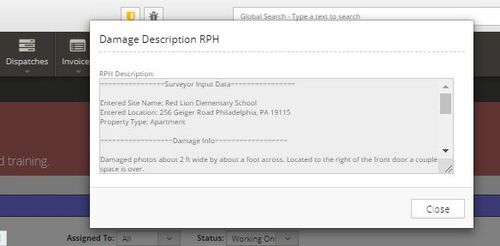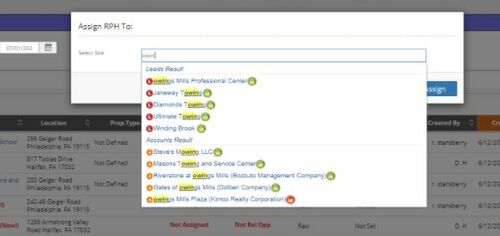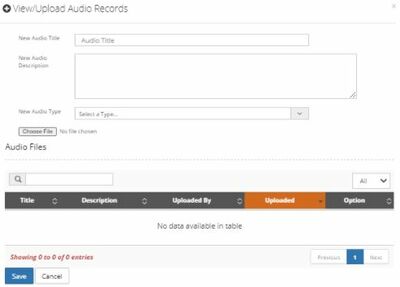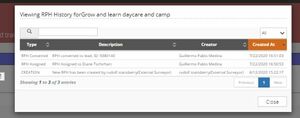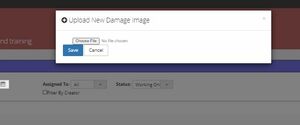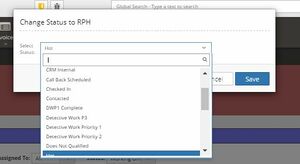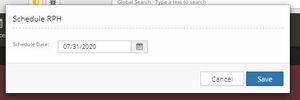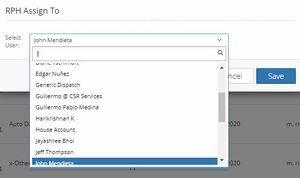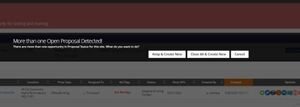Difference between revisions of "RPH"
| Line 1: | Line 1: | ||
=What is an RPH?= | =What is an RPH?= | ||
| − | + | An RPH (Reported Pothole) is like a lite version of a lead from a business perspective. | |
Earlier, every time that the company went out and found a pothole, the account managers could create a Lead for it but not capture the follow-up events such as: Did it become a sale or not? Is anyone interested in having us fix it? This process created a lot of duplicates and didn't allow the company to track the sales evolution. | Earlier, every time that the company went out and found a pothole, the account managers could create a Lead for it but not capture the follow-up events such as: Did it become a sale or not? Is anyone interested in having us fix it? This process created a lot of duplicates and didn't allow the company to track the sales evolution. | ||
| Line 7: | Line 7: | ||
As a result, we decided to differentiate and create a sales process that fit our needs- to track every opportunity over time and connect seamlessly with our customers. | As a result, we decided to differentiate and create a sales process that fit our needs- to track every opportunity over time and connect seamlessly with our customers. | ||
| − | An RPH is a | + | An RPH is a "'reported pothole that exists right now at a site' "and forms the initial step in our process. We know where the pothole is, but we don't know whether it will turn into a Lead or not. Every reported pothole is recorded in our system, whether it is a Lead or an Account. |
=What is the difference between a Lead and an Account?= | =What is the difference between a Lead and an Account?= | ||
| − | Leads and Accounts share a lot of information but the | + | Leads and Accounts share a lot of information, but the significant difference is whether we have done business with the customer or not. When a Lead has a quote, and the quote becomes a sale, the Lead automatically becomes an Account. |
| − | =How is it generated and when?= | + | =How is it generated, and when?= |
| − | There are several different ways in which RPHs | + | There are several different ways in which RPHs are created. |
| − | * Through | + | * Through "'external marketing companies'": With the help of their database and marketing campaigns, we can reach more people interested in hiring our services. |
| − | The external marketing company will use an [[External_Portals|external portal]] to create an RPH or Lead every time they get an answer from a potential customer. This action will generate the correspondent record in our system with their footprint and stamps | + | The external marketing company will use an [[External_Portals|external portal]] to create an RPH or Lead every time they get an answer from a potential customer. This action will generate the correspondent record in our system with their footprint and stamps to know the RPH/ Lead proceeds from their database(*). |
| − | * Through | + | * Through "'manual entry'": This happens, for instance, when a customer calls us, sends an email, visits our website, etc. Typically, these situations require the user to generate the RPH manually. |
| − | * Through | + | * Through "'mobile applications'": By far, our mobile applications create the largest number of records in the system. We hire independent contractors, assign them a territory, and give them a license. They are paid to go out, visit every parking lot they can find, and report the potholes in the mobile application. You can find these records in the system with the "pothole hunter" label. |
| − | (*) | + | (*) We need to know when we get a contact from an independent contractor so they can get paid and credited for it. In some cases, they might also respond to a past customer, follow the same process, and earn the same pay and credit. |
== RPH creation through mobile application == | == RPH creation through mobile application == | ||
| Line 31: | Line 31: | ||
There are two different [[mobile applications]] to create an RPH: | There are two different [[mobile applications]] to create an RPH: | ||
| − | *Lead Generator used by | + | *Lead Generator used by "Hunters": Hunters are temporary independent contractors that generate RPHs. As explained earlier, they "hunt" potholes. |
| − | *Proposal Maker used by | + | *Proposal Maker used by "Surveyors": Surveyors are full-time employees who visit and inspect sites that have requested a quote. |
| − | Both mobile applications allow the user to | + | Both mobile applications allow the user to quickly send the RPH information to the system by following a simple process. The [[Data Analysis Team]] processes the information and analyzes the likelihood of an RPH to become an [[opportunity]] successfully. |
The Hunters and Surveyors must complete/upload at least the following information: | The Hunters and Surveyors must complete/upload at least the following information: | ||
| Line 42: | Line 42: | ||
*Complete site information | *Complete site information | ||
| − | Once the information is uploaded, they need to validate the address. The system triggers a whole validation process of the site database, searching for any existing [[accounts|account]] with the | + | Once the information is uploaded, they need to validate the address. The system triggers a whole validation process of the site database, searching for any existing [[accounts|account]] with the exact address/ location, through an integration with Google Maps with geolocation. |
| − | If the site already exists in the database, then the system will inform the user about it and automatically link to that existing [[Lead]] or [[Accounts|Account]]. As the user finalizes | + | If the site already exists in the database, then the system will inform the user about it and automatically link to that existing [[Lead]] or [[Accounts|Account]]. As the user finalizes RPH creation, the [[Data Analysis team]] will also need to validate it. |
| − | If the site does not exist, then the RPH is created without a linked site, which may be added afterward based on the results | + | If the site does not exist, then the RPH is created without a linked site, which may be added afterward based on the analysis results performed by the Data Analysis Team. One can quickly identify this event on the screen with the icon "[[File:01.1.jpg|frameless]]". |
== Manual RPH creation (through CRM)== | == Manual RPH creation (through CRM)== | ||
| − | In the scenario where a customer directly contacts us or requests for a pothole repair, the CRM allows us to | + | In the scenario where a customer directly contacts us or requests for a pothole repair, the CRM allows us to create an RPH through a quick process manually. To create an RPH manually, the user needs to press the "[[File:Iconplus.jpg|frameless]]" icon on the top right corner of the menu section. |
[[File:101.jpg|1024px|frameless|center]] | [[File:101.jpg|1024px|frameless|center]] | ||
| Line 72: | Line 72: | ||
'''''Contact Information''' (See [[contacts]]) | '''''Contact Information''' (See [[contacts]]) | ||
| − | + | " | |
*First Name | *First Name | ||
*Last Name | *Last Name | ||
| Line 80: | Line 80: | ||
'''''Address Information''' | '''''Address Information''' | ||
| − | + | " | |
*State (Mandatory) | *State (Mandatory) | ||
*City (Mandatory) | *City (Mandatory) | ||
| Line 86: | Line 86: | ||
'''''Damage Info''' | '''''Damage Info''' | ||
| − | + | " | |
*Damage Info (Mandatory) | *Damage Info (Mandatory) | ||
| − | Once completed, all the information is logged in the system database, no matter the source | + | Once completed, all the information is logged in the system database, no matter the RPH source. This action automatically triggers an email to the assigned user, with two possible results: |
| − | *If the site exists, the user needs to verify if the location is | + | *If the site exists, the user needs to verify if the location is linked to the site correctly. |
*If the site does not exist, then the user will analyze it and verify its potential. | *If the site does not exist, then the user will analyze it and verify its potential. | ||
| − | This is what we call | + | This process is what we call " "Detective Work" "and it is explained in the next section. |
= What happens once an RPH is created? = | = What happens once an RPH is created? = | ||
After creation, an RPH can have several outcomes: | After creation, an RPH can have several outcomes: | ||
| − | + | * RPH becomes a sale, and we "close it as won." | |
| − | + | * The RPH does not become a sale but is closed if (a) the decision-maker cannot be reached, (b) lack of interest, or (c) the Account Manager makes a judgment call. | |
| − | + | Thus, the system provides the possibility of applying different kinds of statuses to every RPH and Lead and illustrates the level of progress for the sale process. | |
| − | Every time an RPH is created | + | Every time an RPH is created, the system categorizes it under the "raw" status by default. At this point, what we call the "detective work" begins. The detective work is the process that will take RPH records through the different statuses. |
===So what does detective work mean?=== | ===So what does detective work mean?=== | ||
| − | + | The greatest number of RPHs recorded in the system comes from mobile apps. But how do we know that every RPH generated is a good one and can turn into a Lead? The detective work begins by determining the contact details of whoever is responsible for the property where the pothole is located. By establishing contact with the responsible person, we can create an opportunity. | |
| − | |||
| − | |||
===Statuses: The pathways of an RPH=== | ===Statuses: The pathways of an RPH=== | ||
| − | + | A special team of Data Analysts checks every RPH recorded in the system. | |
| − | + | They check that every record qualifies with the conditions we have for a pothole to be valid. These conditions include size, scope, location, and property type. The Data Analysts also provide the contact information for an initial property contact. | |
| − | Then | + | Then the Data Analysts prioritize these RPHs and the Leads into Tier 1 Leads or Tier 2 Leads. Finally, they will try to answer questions: Does the information already exist in the system, or do we need to do more detective work on it? Is it a duplicate record? Has a hunter tried to upload the same pothole twice to get easy money? |
| − | |||
| − | During the detective work and the following sales representative work, | + | During the detective work and the following sales representative work, though an RPH can go through several statuses and steps, they all come down to the next point: |
| − | + | * There is a chance for a sale or | |
| − | + | * There is no chance for a sale | |
| − | * There is | ||
| − | * | ||
| − | |||
===Nurture P2: a special status=== | ===Nurture P2: a special status=== | ||
Revision as of 18:04, 12 April 2021
What is an RPH?
An RPH (Reported Pothole) is like a lite version of a lead from a business perspective.
Earlier, every time that the company went out and found a pothole, the account managers could create a Lead for it but not capture the follow-up events such as: Did it become a sale or not? Is anyone interested in having us fix it? This process created a lot of duplicates and didn't allow the company to track the sales evolution.
As a result, we decided to differentiate and create a sales process that fit our needs- to track every opportunity over time and connect seamlessly with our customers.
An RPH is a "'reported pothole that exists right now at a site' "and forms the initial step in our process. We know where the pothole is, but we don't know whether it will turn into a Lead or not. Every reported pothole is recorded in our system, whether it is a Lead or an Account.
What is the difference between a Lead and an Account?
Leads and Accounts share a lot of information, but the significant difference is whether we have done business with the customer or not. When a Lead has a quote, and the quote becomes a sale, the Lead automatically becomes an Account.
How is it generated, and when?
There are several different ways in which RPHs are created.
- Through "'external marketing companies'": With the help of their database and marketing campaigns, we can reach more people interested in hiring our services.
The external marketing company will use an external portal to create an RPH or Lead every time they get an answer from a potential customer. This action will generate the correspondent record in our system with their footprint and stamps to know the RPH/ Lead proceeds from their database(*).
- Through "'manual entry'": This happens, for instance, when a customer calls us, sends an email, visits our website, etc. Typically, these situations require the user to generate the RPH manually.
- Through "'mobile applications'": By far, our mobile applications create the largest number of records in the system. We hire independent contractors, assign them a territory, and give them a license. They are paid to go out, visit every parking lot they can find, and report the potholes in the mobile application. You can find these records in the system with the "pothole hunter" label.
(*) We need to know when we get a contact from an independent contractor so they can get paid and credited for it. In some cases, they might also respond to a past customer, follow the same process, and earn the same pay and credit.
RPH creation through mobile application
There are two different mobile applications to create an RPH:
- Lead Generator used by "Hunters": Hunters are temporary independent contractors that generate RPHs. As explained earlier, they "hunt" potholes.
- Proposal Maker used by "Surveyors": Surveyors are full-time employees who visit and inspect sites that have requested a quote.
Both mobile applications allow the user to quickly send the RPH information to the system by following a simple process. The Data Analysis Team processes the information and analyzes the likelihood of an RPH to become an opportunity successfully.
The Hunters and Surveyors must complete/upload at least the following information:
- A photo of the reported pothole
- A leasing picture (a reference place to geolocate the pothole)
- Complete site information
Once the information is uploaded, they need to validate the address. The system triggers a whole validation process of the site database, searching for any existing account with the exact address/ location, through an integration with Google Maps with geolocation.
If the site already exists in the database, then the system will inform the user about it and automatically link to that existing Lead or Account. As the user finalizes RPH creation, the Data Analysis team will also need to validate it.
If the site does not exist, then the RPH is created without a linked site, which may be added afterward based on the analysis results performed by the Data Analysis Team. One can quickly identify this event on the screen with the icon "![]() ".
".
Manual RPH creation (through CRM)
In the scenario where a customer directly contacts us or requests for a pothole repair, the CRM allows us to create an RPH through a quick process manually. To create an RPH manually, the user needs to press the "![]() " icon on the top right corner of the menu section.
" icon on the top right corner of the menu section.
This option shows a form with the following sections:
General information
- RPH status (Mandatory)
- Owner (Mandatory)
- Assign to
- Company/Site (Mandatory)
- Property Type (Mandatory)
- RPH Source (Mandatory)
- Site Source (Mandatory)
- Region (Mandatory)
- Where Obtained
- Next Follow up
- Upload Damage Images
Contact Information (See contacts) "
- First Name
- Last Name
- Direct
- Mobile
Address Information "
- State (Mandatory)
- City (Mandatory)
- Street (Mandatory)
Damage Info "
- Damage Info (Mandatory)
Once completed, all the information is logged in the system database, no matter the RPH source. This action automatically triggers an email to the assigned user, with two possible results:
- If the site exists, the user needs to verify if the location is linked to the site correctly.
- If the site does not exist, then the user will analyze it and verify its potential.
This process is what we call " "Detective Work" "and it is explained in the next section.
What happens once an RPH is created?
After creation, an RPH can have several outcomes:
- RPH becomes a sale, and we "close it as won."
- The RPH does not become a sale but is closed if (a) the decision-maker cannot be reached, (b) lack of interest, or (c) the Account Manager makes a judgment call.
Thus, the system provides the possibility of applying different kinds of statuses to every RPH and Lead and illustrates the level of progress for the sale process.
Every time an RPH is created, the system categorizes it under the "raw" status by default. At this point, what we call the "detective work" begins. The detective work is the process that will take RPH records through the different statuses.
So what does detective work mean?
The greatest number of RPHs recorded in the system comes from mobile apps. But how do we know that every RPH generated is a good one and can turn into a Lead? The detective work begins by determining the contact details of whoever is responsible for the property where the pothole is located. By establishing contact with the responsible person, we can create an opportunity.
Statuses: The pathways of an RPH
A special team of Data Analysts checks every RPH recorded in the system.
They check that every record qualifies with the conditions we have for a pothole to be valid. These conditions include size, scope, location, and property type. The Data Analysts also provide the contact information for an initial property contact.
Then the Data Analysts prioritize these RPHs and the Leads into Tier 1 Leads or Tier 2 Leads. Finally, they will try to answer questions: Does the information already exist in the system, or do we need to do more detective work on it? Is it a duplicate record? Has a hunter tried to upload the same pothole twice to get easy money?
During the detective work and the following sales representative work, though an RPH can go through several statuses and steps, they all come down to the next point:
- There is a chance for a sale or
- There is no chance for a sale
Nurture P2: a special status
Another very special status is the Nurture P2.
Strategically, from a business perspective, there are some accounts that are more attractive than others.
For instance, Kimco Realty Co. has literally hundreds and hundreds of shopping centers, so we could do a lot of business with them. And this kind of account usually has an account manager who is responsible for several of these properties.
On the other hand, there are some accounts that still are important for us, but way smaller in comparison to Kimco. This could be a small food chain like “Joe’s Pizza” who only has 2 or 3 branches in town.
So from a marketing point of view, it wouldn’t make sense to put the same level of effort into getting Joe’s Pizza to have us fix their potholes, as calling one of Kimco’s account managers. Because if we get Kimco, we can gain more properties that are going to translate into far more work over a larger period of time than getting Joe.
Nonetheless there are heaps of pizza shops, drugstores and independent small businesses. It doesn’t mean that we don’t want to help Joe’s Pizza. We definitely want to do business with them and they are going to get the same quality service than any other of our clients.
That is why we have created a Nurturing program to attend these kinds of customers.
Let us remember, our clients are graded in T1, T2 and T3.
Kimco for instance is T1, since they have properties from the East Coast to the West Coast.
Joe’s Pizza on the other side is a T2, as they have 2 or 3 properties in town. So when a pothole hunter finds any of the T2 or T3 Leads, the data analysis team has to objectively confirm all the data, figure out who owns it, find an email address and put it into Nurture Status.
From this point, the system itself takes over and it instantly triggers a full email campaign. It sends out a series of emails and according to the response of the Lead, it will then send another email taking them through different pathways until it is either rejected or a quote is requested. Then from this moment a sales representative will take care to carry on with it.
The goal of this program is to nurture our T2 potential clients with quality information, giving them the attention they need without having to invest so many hours in the day.
Note: when the detective work team makes an error assigning nurture status to an RPH, the system sends a notification email (see below). This can happen when the provided email is bounced, due to a bad email address, name, seplling mistake, etc. This is why there is a hidden RPH status of “invalid email” that the system applies. When this happens, it is resolved by providing good and complete data and resetting the RPH to a nurture status.
What information is visible on the User Interface (UI)?
The RPH´s list contains basic information necessary to further develop the contact and possible opportunity.
The information visible from the UI is:
- Mgment Account: parent account of the site (if exists).
- Site: name of the site or account name.
- Location: coordinates of the location, supported by Google Map API .
- Property type: the kind of building/ construction, E.G.: gas station, shopping mall, etc.
- Assigned to: the person responsible of this account.
- Related opportunity: in case it has an RPH assign to it.
- Status: these are useful to quickly see the level of progress of the detective work executed by the Data Analysis Team.
- Next Action follow up: shows which is the next action scheduled .
- Creator: the person who uploaded the RPH.
- Options: a set of buttons that allows the user to access more actions.
How to see the RPH list
To see the list of existing RPHs the user needs to click on “Reports” menu, and select “Reported PH report”
Filters are available to refine the search
The available filters are:
- From date
- To date
- Assigned to
- Status
Once the filter is applied and the list is shown, a dynamic “Search bar” is also available to reduce the results.
What options are available?
The CRM provides all users with approved access a list of RPHs and the available actions to analyze and work with each of them. The column on the far right is where users will find available options. The options available will vary based on factors such as RPH status, if the RPH is associated with an existing account, among many others.
By using the Options panel, the users can:
Shows the information related to the pothole, provided by the hunter. Such as site name, location and property type, etc. It also includes a description and comments about the pothole like its size, shape and any supporting information like coordinates and google maps search results.
If the RPH contact has an email address registered, it is possible to send an email directly from the system. The user can choose among a set of templates according to the level of progress in which the RPH is. For further information please check the Emails page.
Allows the user to assign the RPH to a specific existing site. This site could be an existing Lead or Account. Is used when the RPH reported needs to be linked to a site already existing in the database in order to avoid the duplication of sites.
The user only needs to click on the button and search for the desired site.
Allows the user to make corrections regarding the site assignment in case the RPH was assigned to an incorrect site. Once the user clicks on the button, the system asks confirmation to remove the relationship between the RPH and the Site
With this function the RPH is quickly converted into a Lead. The system only validates that the RPH has an assignee/owner. For more information please visit the Lead page.
If the conversion is successful the user will receive an in screen notification
In case the RPH has attached an audio (uploaded usually by the RPH creator), the system allows to play those audio files so that the Data Analysis Team or the Owner can capture more information. Also, using the same function, is possible to upload audio files and attach it to the RPH.
The system saves a log of all the actions that are done over the time for the selected RPH, allowing the user to see the historical information and keep track from the earliest stage until the end of the RPH process.
Allows the users to see any image that may have been attached to the RPH for further information.
Let the user add more images for reference by selecting a file from the local disk
The user can change the status of the RPH according to its progress. Each status have a specific meaning and represents a separate stage in the entire process.
The system allows adding a note about the RPH so that further information can be easily captured.
Allows the user to set a new action to follow up RPH conversion. The user can select a date and the system will trigger a notification when the date comes up.
Send Info to another email address![]()
Allows the user to add a different email address and send messages (E-mails) without changing the main one assigned to the RPH.
Allows the users to assign RPHs to specific users depending on the needed action for that RPH.
If the RPH is related to an existing Lead or account, the system allows to quickly create an opportunity from the RPH. The system validates:
- The contact of the Site is correctly uploaded
- There is no other open Opportunity for the selected site. In case there is an opportunity in progress, the system will allow to either close the current opportunity and create a new one, or split the existing one to add this RPH.
If the account related to the RPH is protected, the system will inform and ask the user to decide how to proceed. There are two possible options:
- Create Without Splitting: the user creating the opportunity will not have access to work with the Item since it will be protected by the owner.
- Split With Me:The owner will remain the same, but the opportunity will be managed by the user creating the opportunity.
